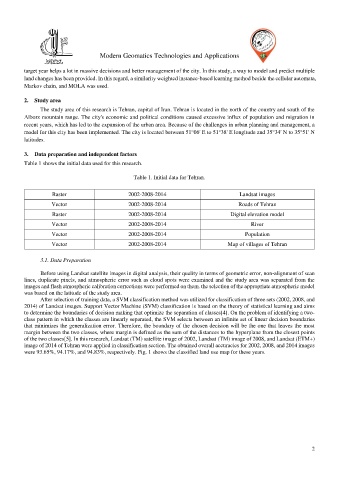Page 793 - NGTU_paper_withoutVideo
P. 793
Modern Geomatics Technologies and Applications
target year helps a lot in massive decisions and better management of the city. In this study, a way to model and predict multiple
land changes has been provided. In this regard, a similarity weighted instance-based learning method beside the cellular automata,
Markov chain, and MOLA was used.
2. Study area
The study area of this research is Tehran, capital of Iran. Tehran is located in the north of the country and south of the
Alborz mountain range. The city's economic and political conditions caused excessive influx of population and migration in
recent years, which has led to the expansion of the urban area. Because of the challenges in urban planning and management, a
model for this city has been implemented. The city is located between 51°06' E to 51°38' E longitude and 35°34' N to 35°51' N
latitudes.
3. Data preparation and independent factors
Table 1 shows the initial data used for this research.
Table 1. Initial data for Tehran.
Raster 2002-2008-2014 Landsat images
Vector 2002-2008-2014 Roads of Tehran
Raster 2002-2008-2014 Digital elevation model
Vector 2002-2008-2014 River
Vector 2002-2008-2014 Population
Vector 2002-2008-2014 Map of villages of Tehran
3.1. Data Preparation
Before using Landsat satellite images in digital analysis, their quality in terms of geometric error, non-alignment of scan
lines, duplicate pixels, and atmospheric error such as cloud spots were examined and the study area was separated from the
images and flash atmospheric calibration corrections were performed on them. the selection of the appropriate atmospheric model
was based on the latitude of the study area.
After selection of training data, a SVM classification method was utilized for classification of three sets (2002, 2008, and
2014) of Landsat images. Support Vector Machine (SVM) classification is based on the theory of statistical learning and aims
to determine the boundaries of decision making that optimize the separation of classes[4]. On the problem of identifying a two-
class pattern in which the classes are linearly separated, the SVM selects between an infinite set of linear decision boundaries
that minimizes the generalization error. Therefore, the boundary of the chosen decision will be the one that leaves the most
margin between the two classes, where margin is defined as the sum of the distances to the hyperplane from the closest points
of the two classes[5]. In this research, Landsat (TM) satellite image of 2002, Landsat (TM) image of 2008, and Landsat (ETM+)
image of 2014 of Tehran were applied in classification section. The obtained overall accuracies for 2002, 2008, and 2014 images
were 93.65%, 94.17%, and 94.83%, respectively. Fig. 1 shows the classified land use map for these years.
2

